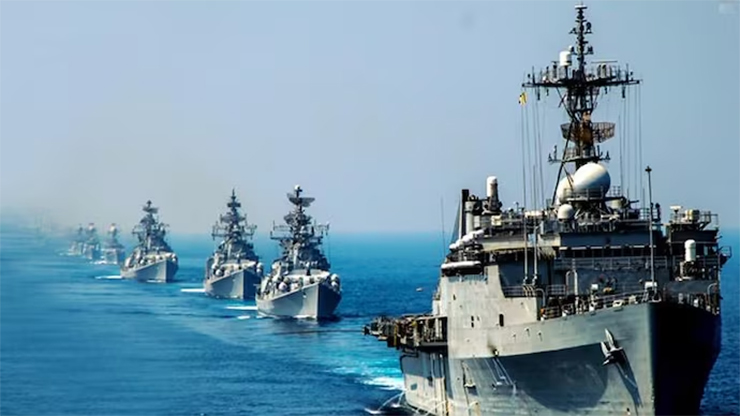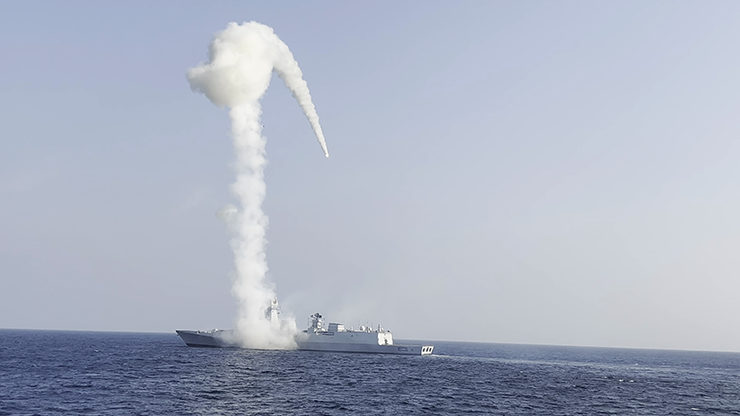
“No big modern war has been won without preponderant sea power, and conversely, very few rebellions of Maritime Provinces have succeeded without acquiring sea power,” said noted American maritime historian Samuel Eliot Morison.
As the Indian Navy celebrates December 4 as the Navy Day every year to highlight its role in protecting the nation along its coasts and commemorate its achievements in the 1971 Indo-Pakistan War, the above words hold true. In fact, New Delhi is well on its way towards building strong strategic partnerships and presence in the Indo-Pacific.
This is vital and necessary as its northern neighbour China’s Peoples Liberation Army Navy (PLAN), is fast racing to become the number one naval power in the world, overtaking the US. In this context, it becomes imperative for India, which has the seventh largest Navy in the world to modernise and expand its naval fleet at a fast pace.
China’s Peoples Liberation Army Navy (PLAN), is fast racing to become the number one naval power in the world, overtaking the US. Thus, it becomes imperative for India, the seventh largest Navy in the world, to modernise and expand its naval fleet at a fast pace
It would be relevant here to note that acclaimed naval historian Alfred Thayer Mahan, saw the sea as a “great highway” and a “wide common” over which commerce and military forces flowed freely, Mahan described “sea power” as an indispensable instrument of state power, and “maritime access” – commercial, diplomatic, and military – as the critical elements of maritime strategy. Comprehensive access to vital sea spaces, he averred, had the potential to propel a nation to a great power status.
New Delhi’s biggest challenge in the maritime domain currently is undoubtedly China. Since 2008, when Beijing first sent its warships to the Gulf of Aden for anti-piracy duties, China’s military presence in the eastern Indian Ocean has significantly expanded.
Beijing has sought to exert influence over the Bay of Bengal states through investments and infrastructure development projects. Bangladesh, Myanmar, Sri Lanka, and Thailand have all benefited from China’s Belt and Road Initiative (BRI), as has Pakistan, China’s all-weather friend in South Asia. Some countries have even allowed Chinese-built commercial facilities on their territory to be used for quasi-military purposes.
According to World Directory of Military Modern Warships (MDMMW), China’s PLAN has around 300,000 naval personnel, a fleet of 700 plus ships including over 230 auxiliary vessels. It operates J-10, J-11, SU-30MK and J-15 fighter jets. Its fleet comprises three aircraft carriers (latest is CNS Fujian), two helicopter carriers, 51 destroyers, 50 frigates, 71 corvettes and 80 submarines.
India is acquiring a range of war fighting platforms and other assets to create a versatile and adaptable force, capable of action at many levels
To counter China, India has sought to build maritime muscle and increase its naval presence in the Indian Ocean. The Indian Navy has embarked on an ambitious plan to create a 175-ship force by 2035, setting milestones to push indigenisation and cast away the dependence on foreign suppliers.
Currently, India is building 41 one of the 43 ships at Indian shipyards, with proposals to build 49 more ships and submarines in the approval pipeline. In order for the Indian Navy to be self-reliant by 2047, naval commanders are focused on futuristic capability development, devising plans to overcome complex security challenges in the maritime domain.
In addition, a range of war fighting platforms and assets are being acquired to create a versatile and adaptable force, capable of action at many levels.
However, the pace of naval ship construction in India is struggling to keep pace with strategic needs. The Indian Navy’s capital budget is small and the pace of construction of the ships much slower than China’s. Although India is building more warships now as compared to previously, the asymmetry with the PLAN is still stark. In contrast to China, which builds almost 14 warships a year, India constructs just four.

The deficit in the undersea domain for India is particularly glaring. Even after the induction of five Scorpene (Kalvari) class submarines, the Indian Navy is eight boats short of the stipulated 24 scheduled for induction by 2030, in accordance with the Navy’s 2012–27 Maritime Capability Perspective Plan (MCPP).
With the older Kilo and HDW/Shishumar class boats due for decommissioning, the Indian Navy has pinned its hopes on Project 75-I, which is yet to take off. On the upside, New Delhi has bolstered its maritime strategic posture through partnerships. India’s political leadership has made ‘rules-based security’ a priority, with efforts to improve coordination with regional partners.
Indian Navy, which sees itself as a first responder to crises in the Indian Ocean, has been at the forefront of cooperative endeavours with other nations in Bay of Bengal, ASEAN countries, and Quad powers
The Indian Navy, which sees itself as a first responder to crises in the Indian Ocean, has been at the forefront of cooperative endeavours with nations in Bay of Bengal, ASEAN countries, and Quad powers. A key strategic objective is to improve interoperability with partner navies and build capabilities of smaller partners.
Shore-based radar chains, satellite systems, and an information fusion centre in Gurugram, Haryana, have helped regional navies and coastguards improve their response to crises.
India’s political leadership has made ‘rules-based security’ a priority, with efforts to improve coordination with regional partners. Yet, challenges in the non-traditional realm persist. While situational awareness in the littorals has improved considerably, the Indian Navy finds itself stretched in the littorals.
The problem, as many describe it, is a lack of law enforcement capacity. Dealing with threats such as piracy, drug and contraband trafficking, armed robbery, human smuggling, and illegal migration requires constant vigilance in the commons. But many of India’s neighbours have limited naval and coast guard capabilities.
The mission set in South Asia is rendered complex by the blurring of lines between conventional and irregular threats. If the Indian Navy has focused disproportionate energy and resources on littoral security, it is because naval planners have had few options.
To be sure, maritime power is more than a matter of policing the commons or accumulating and projecting military force in the littorals. Sea power is equally about creating prosperity for the people and meeting the needs of national development. Here, India’s Maritime Vision 2030 merits mention. The 10-year blueprint for the maritime sector envisages the development of ports, shipping, and inland waterways.
According to the recently released World Bank’s Logistic Performance Index (LPI) Report 2023, India is at the 22nd rank in global rankings in the “International Shipments” category (up from the 44th position in 2014) and 38th rank on the LPI score – a notable improvement by any measure. Not coincidentally, the ocean-based economy was a subject of much interest and debate at recent G-20 discussions under India’s presidency, earlier this year.
Since it was announced in February 2021, India’s ports and maritime logistics sector has shown significant growth. If port-driven industrialisation is a bright spot for New Delhi, maritime governance remains a problem area, particularly the vexing issue of illegal and excessive resource exploitation.
Maritime power is not just policing the commons or accumulating and projecting military force in the littorals. Sea power is equally about creating prosperity for the people and meeting the needs of national development
In recent years, illegal fishing in the Indian Ocean littorals has grown exponentially. Extra-regional distant water fishing fleets are mainly to blame, but the problem can also be attributed to lax regulatory implementation and faulty policies that encourage unsustainable fishing practices.
With the marine habitat and biodiversity in rapid decline and climate change and extreme weather events on the rise, the Indian Navy and Indian Coast Guard are being increasingly called upon to police vulnerable sea spaces and deliver humanitarian and disaster relief to coastal communities.
This significantly reduces the operational bandwidth for distant seas operations. India’s maritime theorists and practitioners are coming to grips with the reality that they are no longer in an era when military force and command of the seas were a sure route to great power status.
Today’s time is more complex, not only on account of globalisation and economic interdependence, but also because of growing non-traditional challenges and a shrinking appetite among maritime states for naval conflict (notwithstanding developments in the Black Sea and the South China Sea).
Countering maritime threats today needs partnerships and collaborative synergy to sustain security initiatives in the littorals. Partnerships are exactly what India has its sights set on in the Indo-Pacific region.
Countering maritime threats today needs partnerships and collaborative synergy to sustain security initiatives in the littorals. Partnerships are exactly what India has its sights set on in the Indo-Pacific region
As K M Pannikar wrote in his book “India and the Indian Ocean,” that despite countless invasions from India’s North-West border over centuries, India “never lost her independence till she lost command of the sea in the first decade of the sixteenth century.”
It was then that the European colonial powers moved in. Modern India may not fear an invasion from the sea, but it would do well to remember its history and to keep in mind that security of the homeland is not limited to land borders.
The waters around India offers New Delhi with the best means for unshackling itself strategically. The Indian Ocean provides India with an opportunity to become the dominant strategic and economic player across a vast expanse off the eastern coast of Africa, West Asia and even South-East Asia.
The world’s third largest ocean should be the cornerstone of India’s Indo-Pacific strategy. While a “free and open” Indo-Pacific refers to a much larger geographical area, India’s focus should be on ensuring to drive the narrative, in the Indian Ocean in conjunction with like-minded partners.
India’s drive for peace and prosperity cannot stop at its land borders with its two largest neighbours; it must also extend southwards and include the Indian Ocean, too in its strategy.
– The writer is a senior journalist and media consultant. The views expressed are of the writer and do not necessarily reflect the views of Raksha Anirveda















